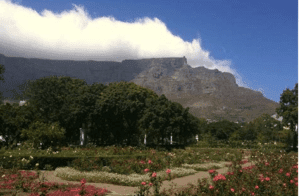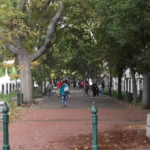The Company’s Garden
In the beginning
The Company’s Garden is where Jan Van Riebeek and the early settlers planted vegetables and fruit to supply food for themselves and for passing ships. Ships sent by the Dutch East India Company would stop en route to the East after months at sea and stock up on fresh produce. The birth of the garden, however, can be traced back as far as 1644 when the Dutch ship the “Haarlem” was grounded at Bloubergstrand. The stranded crew made their way to a stream of fresh water and anticipating a long wait, they planted some seeds, They survived by bartering with locals and harvesting the vegetables they grew.
About six months later the survivors were picked up by the Dutch fleet returning from Batavia. On returning to the Netherlands two of the survivors suggested to the Directors of the Dutch East India Company what would be derived from a refreshment station at the Cape.
The formal garden was laid out by Jan Van Riebeek in 1652 on 18 ha. It was divided by walkways. Master gardener and free burger Hendrik Boom prepared the first ground for the sowing of seed on 29 April 1652. The first things they planted were salad herbs, peas, large beans, radishes, beet, spinach, wheat, cabbage, asparagus, and turnips.
Trees and silk
In the garden, you can find the oldest pear tree in South Africa a Saffron Pear, Astonishingly this tree still flowers and bears fruit. It was brought here from Holland during the time of Van Riebeek. It is most likely the oldest cultivated tree in Cape Town. The main trunk died back but three shoots radiate from the original trunk. The rotted original trunk has been treated with a sealant and cables hold the tree in place
Water for the garden comes from the Molteno dam which is filled by the springs on the slopes of Table Mountain. A long broad walkway called the Avenue bisects the garden. It was lined with orange and lemon trees that have since been replaced with elm and oak trees.
Until 1680 the Company’s Garden was mainly used to produce vegetables. Later Simon Van der Stel laid out some of the ground to grow more ornamental plants and flowers. The garden superintendent and Botanist Hendrik Bernard Oldenland compiled a herbarium This was a collection of dried plants mounted, and labelled, which was sent to the Netherlands after his sudden death. In 1770
There is also a wizened black mulberry tree (Morus nigra) in the garden This Persian tree was cultivated across much of the old world, partly for the fruit and partly for the leaves which are eaten by silkworms. Thus “feeding” the silk industry. In 1704, Willem Adrain van der Stel wanted to establish a local silk industry. ‘Die Oude Spinnery’ (the old spinning factory) was constructed on what is now Spin Street, alongside the Company’s Garden. He imported silkworms that fed on the leaves of the black mulberry trees that were cultivated in the garden. Slave children had the job of unspinning their cocoons. The black mulberry tree in the Company’sgarden dates to 1800 and is probably the offspring of one planted to support the new silk industry. The industry for several reasons did not take off and so it was abandoned. In 1753 the spinning factory was converted into a grain depot. Unfortunately, this depot burned down in 1792.
 .
.
Things to look out for in the garden
- A rose garden was designed and built in 1929 with a fish pond, an aviary, a herb, and a succulent garden.
- Relax on the lawn, have a picnic, and watch the world go by.
- There are several historic statues to see plus a memorial to Delville Wood a battle that took place in France when a predominantly South African force of more than 3,000 soldiers was reduced to 755 survivors by German forces.
- See some other lesser-known historical sites. Find the Rutherford Fountain which still stands on the original spot where it was erected in 1864. The well pump is embedded in an oak tree that dates back to 1842. This large tap, also dated 1842, protrudes from the trunk
- In the garden, you can also find an 80-year-old bamboo plantation, with lovers’ initials carved into the trunks over the years.
- A herb garden which is labeled in braille,
- The ornamental sundial that was built in 1781,
- The slave bell,
- An aviary,
- A wisteria arbor.
- Take a Guided walk with Voice Map
- City walks begin at the Company’s Gardens. Phone to confirm dates and meeting places. will take place monthly on Saturdays. A manageable walk even for prams, or little ones that are not used to walking far.021 419-1881
- Children love to visit the gardens and feed the squirrels that are quite tame and will eat from your hands. packets of peanuts are sold by vendors in the gardens.
- There is a restaurant in the gardens, with seating under the shady trees. 021 423 2919
coordinates -33° 55′ 36.2617″, 18° 25′ 0.3659″
15 Queen Victoria Street Cape Town


